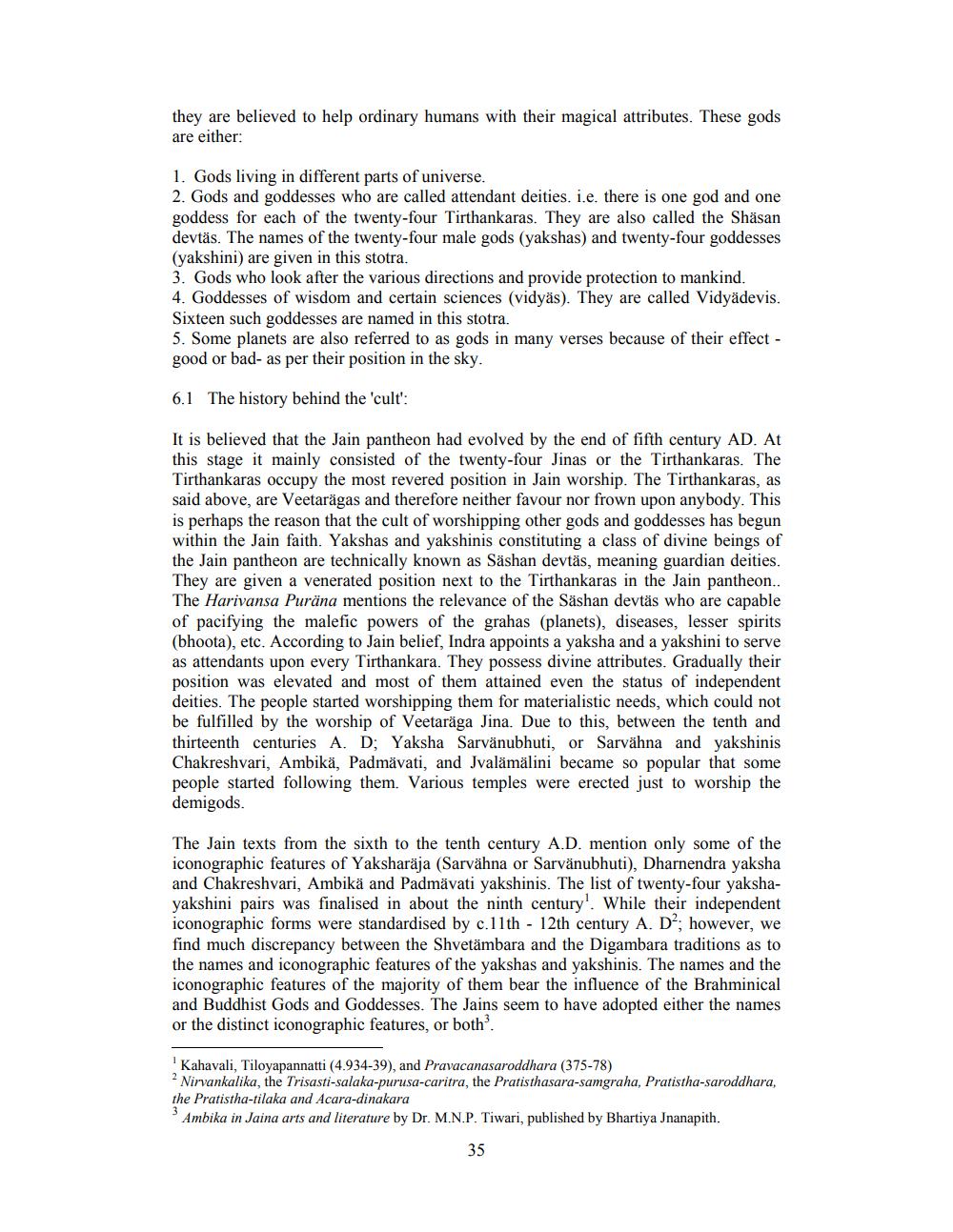________________
they are believed to help ordinary humans with their magical attributes. These gods are either:
1. Gods living in different parts of universe. 2. Gods and goddesses who are called attendant deities. i.e. there is one god and one goddess for each of the twenty-four Tirthankaras. They are also called the Shasan devtäs. The names of the twenty-four male gods (yakshas) and twenty-four goddesses (yakshini) are given in this stotra. 3. Gods who look after the various directions and provide protection to mankind. 4. Goddesses of wisdom and certain sciences (vidyas). They are called Vidyädevis. Sixteen such goddesses are named in this stotra. 5. Some planets are also referred to as gods in many verses because of their effect - good or bad-as per their position in the sky.
6.1
The history behind the 'cult':
It is believed that the Jain pantheon had evolved by the end of fifth century AD. At this stage it mainly consisted of the twenty-four Jinas or the Tirthankaras. The Tirthankaras occupy the most revered position in Jain worship. The Tirthankaras, as said above, are Veetarägas and therefore neither favour nor frown upon anybody. This is perhaps the reason that the cult of worshipping other gods and goddesses has begun within the Jain faith. Yakshas and yakshinis constituting a class of divine beings of the Jain pantheon are technically known as Säshan devtäs, meaning guardian deities. They are given a venerated position next to the Tirthankaras in the Jain pantheon.. The Harivansa Puräna mentions the relevance of the Säshan devtäs who are capable of pacifying the malefic powers of the grahas (planets), diseases, lesser spirits (bhoota), etc. According to Jain belief, Indra appoints a yaksha and a yakshini to serve as attendants upon every Tirthankara. They possess divine attributes. Gradually their position was elevated and most of them attained even the status of independent deities. The people started worshipping them for materialistic needs, which could not be fulfilled by the worship of Veetaräga Jina. Due to this, between the tenth and thirteenth centuries A. D; Yaksha Sarvänubhuti, or Sarvähna and yakshinis Chakreshvari, Ambikä, Padmavati, and Jvalämälini became so popular that some people started following them. Various temples were erected just to worship the demigods.
The Jain texts from the sixth to the tenth century A.D. mention only some of the iconographic features of Yaksharaja (Sarvähna or Sarvänubhuti), Dharnendra yaksha and Chakreshvari, Ambikä and Padmavati vakshinis. The list of twenty-four yakshayakshini pairs was finalised in about the ninth century'. While their independent iconographic forms were standardised by c. 11th - 12th century A. D'; however, we find much discrepancy between the Shvetämbara and the Digambara traditions as to the names and iconographic features of the yakshas and yakshinis. The names and the iconographic features of the majority of them bear the influence of the Brahminical and Buddhist Gods and Goddesses. The Jains seem to have adopted either the names or the distinct iconographic features, or both'.
Kahavali, Tiloyapannatti (4.934-39), and Pravacanasaroddhara (375-78) Nirvankalika, the Trisasti-salaka-purusa-caritra, the Pratisthasara-samgraha, Pratistha-saroddhara, the Pratistha-tilaka and Acara-dinakara Ambika in Jaina arts and literature by Dr. M.N.P. Tiwari, published by Bhartiya Jnanapith.
35




